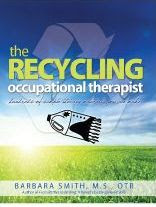Visual Techniques for Developing Social Skills is not only a useful tool for teachers, therapists (and parents, too) who want concrete directions on how to provide social skills training but is also a thought provoking description of how social deficits impact lives of children with high functioning autism and asperger’s syndrome. As an occupational therapist and mother of a young adult with asperger’s syndrome I appreciate Rebecca Moyes’ emphasis on addressing these issues in the Individual Educational Plan (IEP) in the same nonjudgmental manner one would treat dyslexia or coordination problems.
Using skills gained as a teacher, author, parent and presenter, Moyes has organized the chapters in logical, skill building sequence beginning with an introduction that explains
· why social skill building activities and lesson are essential
· how to be positive using reinforcement, utilizing a child’s strengths and understanding the important difference between incompetent and noncompliant behaviors
· the logistics of creating groups that include both children with disabilities and typically developing role models
Social skills training begins with learning about interpersonal interactions and I love the activities designed to promote eye contact, maintain appropriate personal space and respect for other’s belongings. As the book’s title suggests many visual strategies are described- such as a game involving looking at a sticker placed between someone’s eyes to promote approximate eye contact and hoola hoops that enable students to see and feel socially acceptable personal space. Moyes actually describes an eclectic approach that includes
· Reading/listening to social stories
· Role playing
· Games
· Use of videotaping
I like the frequent use of contrast to get across a concept. For example, Moyes might suggest that one child lean across another student’s desk to demonstrate an intrusion into personal space.
Lessons related to developing communication skills involve handling objects such as a colander to explain how children need to filter their words. Speedometers, scales, visual schedules and traffic lights are other visual strategies used to teach about speech volume, speed, prosody and perseveration.
The last section about working successfully in groups may be the most thought provoking because this is an area where many children on the autism spectrum struggle. Reading this reminded me of when my son had been required to work on school group projects. This created a great deal of anxiety because he wanted a good grade and thought it unfair that his grade depended on others. Of course, the social skills groups described in this book are therapeutic and not graded but I think it would have been relevant to discuss dealing with the reality of school demands.
Moyes suggests an activity where each student chooses a group role (such as editor or artist). Group behavior is complex in general and here is where I would have liked a bit more description of various types of group projects that were successful, why and how they were adapted to meet the needs of individual students.
As Moyes explains, learning about another person’s perspective can be very challenging and frustrating and again Moyes does an excellent job of explaining the types of barriers children face. Readers will learn how children need to differentiate “acquaintances” from “friends”, when behaviors cross the line and become ‘stalking” and that lessons need to be short, pleasurable and involve positive reinforcement. Moyes explains how children learn about points of view by:
· Sharing a similar experience yourself
· Talking about having a similar experience
· Imagining what it feels like to feel the way the person is feeling because you can “put yourself” into their experience.
Moyes suggests that lessons involve learning perspective by discussing social stories and role playing with the assumption that there is no right or wrong answer as to how characters feel because one cannot know for sure what is going on in the mind of the person in the story. This is useful but I would also like to learn what to do when students clearly have socially unacceptable values. For example, a child might feel that no one should cry over the death of a pet because now the owners won’t have to spend money feeding it. Many people would find these values offensive, so how is a student to know which ideas to share and which to keep to himself?
I highly recommend Visual Techniques for Developing Social Skills. No matter what your discipline or role in the child’s life- this book provides insight into the social challenges faced by students on the autism spectrum and the educational systems obligations to address them. Every school should purchase a copy and let the programs begin!
If you purchase from Future Horizons use the code PEDIA to get 15% off.
If you purchase from Future Horizons use the code PEDIA to get 15% off.







No comments:
Post a Comment